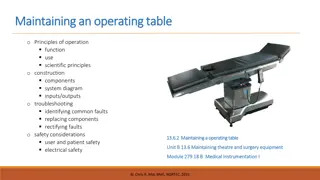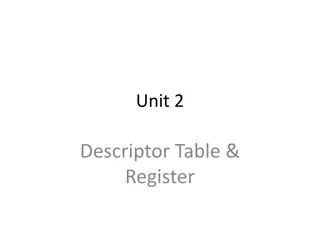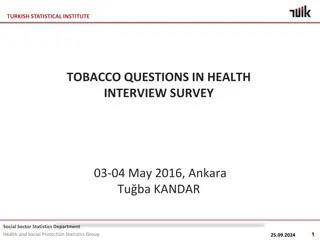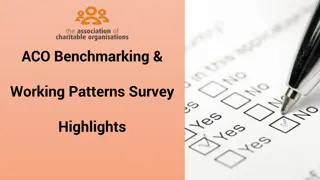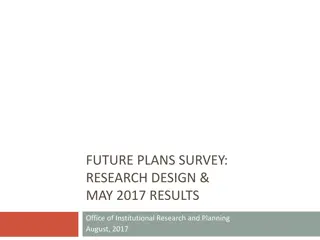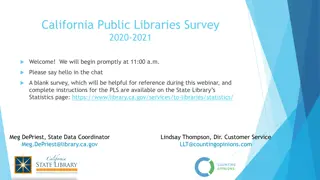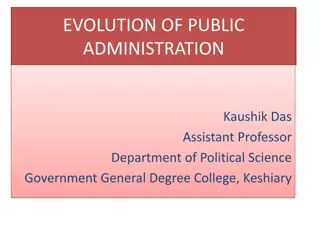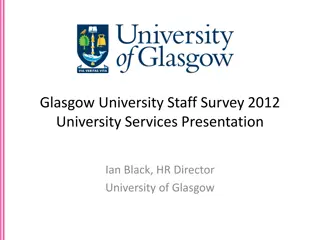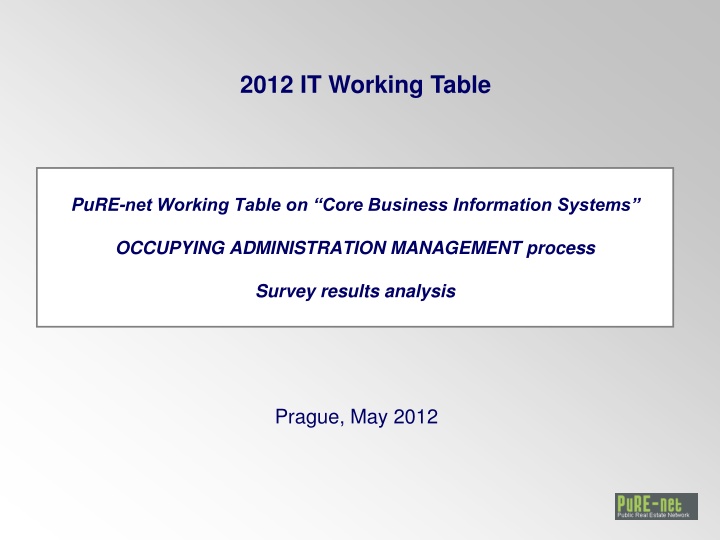
2012 IT Working Table - Administration Management Process Survey
The 2012 IT Working Table on Core Business Information Systems conducted a survey to assess administration management processes across different countries. The questionnaire delved into various aspects such as context setting, strategy and relationship management, management and enablers, and operations and outcomes. The survey results highlighted differences in organizational missions and strategies among participating countries like Belgium, Czech Republic, Estonia, France, Italy, and the Netherlands.
Download Presentation

Please find below an Image/Link to download the presentation.
The content on the website is provided AS IS for your information and personal use only. It may not be sold, licensed, or shared on other websites without obtaining consent from the author. If you encounter any issues during the download, it is possible that the publisher has removed the file from their server.
You are allowed to download the files provided on this website for personal or commercial use, subject to the condition that they are used lawfully. All files are the property of their respective owners.
The content on the website is provided AS IS for your information and personal use only. It may not be sold, licensed, or shared on other websites without obtaining consent from the author.
E N D
Presentation Transcript
2012 IT Working Table PuRE-net Working Table on Core Business Information Systems OCCUPYING ADMINISTRATION MANAGEMENT process Survey results analysis Prague, May 2012
The Questionnaire Occupying Administration Management process assessment questionnaire has been defined with the goal to collect compare organisational and technical issues of the process The questionnaire is divided in 4 sections: A) Context setting B) Strategy and Relationship management C) Management and Enablers D) Operations and Outcomes Key Performance Indicators 2
The Questionnaire Survey analysis is based on 6 responding countries: BELGIUM Buildings Agency (BA) CZECH REPUBLIC Office for Government Representation in Property Affairs (OGRPA) ESTONIA State Real Estate Ltd (SRE) Ministry of Finance of the Republic of Estonia (GOV) FRANCE France Domaine ITALY Agenzia del Demanio THE NETHERLANDS Rijksgebouwendienst-Government Buildings Agency (Rgd) 3
A) Context setting QUESTION 1: How many State buildings (in your portfolio) are used as Government offices? FOCUS: Percentage of State buildings used as Government offices is very different among countries. The lower is in CZECH REPUBLIC (4.4%), the higher in ITALY (66%). Data highlights different organisational missions . Those differences impact on priorities and strategies concerning process management issues 4
A) Context setting Organisation s portfolio : percentage of BUILDINGS used as Government offices(question A1) 5
A) Context setting QUESTION 2: How many assets are rented from the market for Government office purpose? CZECH R. = 12% ESTONIA = 10% The NETHERLANDS = 27% ITALY = 33% BELGIUM 54% FRANCE 55% 3 different cluster = 3 different strategy/choice ? (Some data to be verified 6
A) Context setting QUESTION 3: types ? Level of standardisation of the Gov. offices in terms of building LOW LEVEL of Standardization (a lot of dfferent buildings type/structures / layout HIGH LEVEL of standardisation (few different types of buildings/layout) MEDIUM LEVEL of standardisation BELGIUM X CZECH R. X ESTONIA X FRANCE X ITALY X NETHERLANDS X 7
A) Context setting QUESTION 4: Are there any specific rules/regulations concerning criteria or standard (e.g. building characteristics, location, etc.) to be considered in defining (selecting) State and private assets to be used as government offices? CZECH : Administrative building code (location, refurbishment rules, etc.) ESTON IA : Not yet Quality and location ITALY: fee evaluation for market rented buildings and Administration needs evaluation (case by case) FRANCE: fee limit for market rented buildings BELGIUM: Energy efficiency and accessibility to public transports system, THE NETHERLANDS : Access to public transport system 3 clusters ? Strategic view to be clarified 8
A) Context setting QUESTION 5: Are there any layout/furniture specific rules/regulations (or standards) to be applied in defining / designing spaces to be used as government offices? (e.g: rules concerning m per person based on the employee function, rules concerning image (identity) of the government office spaces, etc.) CZECH R. : Occupancy standard (including facilities specifications) BELGIUM : Occupancy standard (including facilities specifications) ITALY: Occupancy standard (to be updated and applied) FRANCE: Occupancy standard THE NETHERLANDS : Occupancy standard ESTONIA : Occupancy standard (to be set) There are no specific criteria concerning building internal layout (space configuration not occupancy performance rules) and furnitures. Is this a specific choice (coherent with the low level of standardisation) ? 9
A) Context setting QUESTION 6: Does the tenant administration allocated in a State building pay nay rent (real or notional) ? No RENT NOTIONAL RENT REAL RENT BELGIUM X * (Local authorities only) CZECH R. If SRE is the owner X (for the first 2 years) If SRE is the owner X (after the first 2 years) X No if the State is the owner ESTONIA FRANCE X X (to be updated and applied) ITALY NETHERLANDS X 10
B) Strategy and Relationships management QUESTION 1: Which are your organization / your government strategic priorities? HIGH STRATEGIC PRIORITIES Reducing running costs (energy, maintenance, etc.) is a high priority for all organisations involved (level 2 or 3) Space efficiency through sqm x employee reduction is a high level priority for Belgium, Estonia, France and Netherlands (level 3), Italy (2) LOW STRATEGIC PRIORITY Adopting market solution rather than public solution is considered a high priority only by Ministry of Finance of Estonia (level 3). For all other countries it is a low strategic prioy. 11
B) Strategy and Relationships management Strategic priorities overall ranking of all participant countries (question B1) 12
B) Strategy and Relationships management STRATEGIC PRIORITIES (question B.1) BEL CZE EST EST (GOV) FRA ITA* NETH FROM 0 (NONE) TO 3 (HIGH) (SRE) Efficiency on space utilisation 3 0 1 3 3 2 (3) 3 Improve customer (tenant) satisfaction 1 1 3 2 1 0 1 Reducing running cost 2 3 3 3 2 2(3) 3 Reducing environmental impact 3 1 2 2 2 1(2) 2 Reducing market rented buildings 0 2 0 0 2 3 3 Adopting market solutions 0 0 - 3 0 0 1 Relocating government offices to less expensive spaces 0 2 0 1 2 0 (1) 1 Concentrate Departments/Ministries in a dedicated area 1 0 1 3 0 0 3 Changing / Reviewing Depart./ Ministries organisation 2 1 2 2 0 0 0 * Recent changes (priorities to be updated ) 13
C) Management and Enablers QUESTION 1: Roles and responsibilities regarding the PROCESS Occupying Administration Management Proactive analysis ??? To be verified BELGIUM BA To be verified CZECH R. Administration request OGRPA+Other OGRPA OGRPA OGRPA ESTONIA Tenant Tenant SRE+Tenant SRE SRE Gov. Administration express needs than negotiation FRANCE France Domaine+ User administration France Domaine+ User administr. User Administr. France Domaine Gov. Administration express needs than negotiation ITALY Agenzia Demanio+ User admin. Agenzia Demanio+ User admin. User Administr. Agenzia Demanio Administration housing request User Administr. NETHERLANDS Rgd Rgd Rgd The Key strategic difference 14
C) Management and Enablers QUESTION 2: How many human resources (employees) work on this process ? RESOURCES/ FTE ASSETS per RESOURCE ASSETS BELGIUM 470 687 1,5 ESTONIA 32 491 15,3 850 NETHERLANDS 2.540 2,7 +100 external CZECH R.* 132* 79* 0,6 Countries with a direct management responsibility DATA TO BE VERIFIED ACCORDING TO VARIOUS DIFFERENT SPECIFIC ROLE IN TERMS OF MANAGEMENT ISSUES * Data includes office directly used by OGRPA. 15
C) Management and Enablers QUESTION 2: How many human resources (employees) work on this process ? RESOURCES/ FTE ASSETS per RESOURCE ASSETS FRANCE 200 27.000 135 ITALY 170 30.000 176 Countries without a direct Management responsibility (building management carried out by the tenant administration) Differences are to be verified according to possible different operational responsibilities and processes 16
C) Management and Enablers QUESTION 3: How IT systems support the process ? Hydra Internal RE Database Hydra Internal RE Database BELGIUM Manually, Excel Document management CZECH R. IS IS IS Sharepoint + Archibus FM Archibus FM Archibus FM ESTONIA Excel Excel User admin. tools Chorus (RE-Fx) FRANCE Chorus Chorus RE-Fx REMS (RE Management System) REMS (RE Management System) PORTALE PA ITALY PORTALE PA NETHERLANDS Oracle sales Horizon Horizon 17
C) Management and Enablers QUESTION 3: How IT systems support the process ? Which kind of specific IT priorities are to be implemented in supporting process management? WHAT ABOUT PRODUCTION ??? (Planning and reporting) 18
C) Management and Enablers QUESTION 4: What kind of data are managed in the supporting software concerning physical and technical aspect of the properties assigned/used as government offices? MOST COMMON PHYSICAL DATA (State owned prevailing) Address, location, city, region, etc. Cadastral data (mainly authomatically integrated with Cad. Data Base) Type of ownership (100% state owned?) Pictures, floor plans, maps, etc. Gross surface/area, n of floors, etc. Description/type of the building Cultural Heritage restrictions/protections MAIN NEEDS / ISSUES BELGIUM: - Incompleteness of multimedia files (maps, scans, etc. not updated) - Surface/dimensions data not updated ITALY: - Overall quality of the data 19
C) Management and Enablers QUESTION 5: What kind of data are managed in the supporting software concerning administrative and user aspects of the properties assigned/used as government offices? MOST COMMON ADMINISTRATIVE/USER DATA Contract/assignement infos (starting date, expiring date, duration, ev. renewal date, etc.) Tenant/user infos (Ministry, Dept., etc.) FTE and n of resources MAIN NEEDS / ISSUES BELGIUM: High criticality in collecting persons/FTE occupying buildings Consequently, high difficulty in FTE/sqm reduction ITALY Overall Quality of the data 20
C) Management and Enablers QUESTION 6: What kind of data are managed in the supporting software concerning economic/financial aspects of the properties assigned/used as government offices? MOST COMMON ECONOMIC/FINANCIAL DATA Building value (market, State balance, ect.) Rent/fee (total, annual) Maintenance costs/expenses Refurbishment costs/investments Taxes and local taxes LESS COMMON DATA Costs for security measurement (Netherlands) Acquisition cost (Estonia) Priorities (in your point of view) ? 21
C) Management and Enablers QUESTION 7: What kind of data are managed in the supporting software concerning green aspects of government offices? the properties assigned/used as MOST COMMON ENERGY CONSUMPTION AND GREEN DATA Electricity, gas, fuel, refreshing, heating, water consumptions LESS COMMON ENERGY CONSUMPTION AND GREEN DATA Nowadays, Netherlands is the only country/organization where Green/Energy Performance Label is showed on the system Future development ? 22
D) Operations and Outcomes Key Performance Indicators QUESTION 2: Are there any Key Performance indicators (and related standard) used by your organisation to monitor the proper and effective use of the assigned / rented building? HIGHLIGHTS (Space per person standards) FRANCE -12 sqm/FTE (TARGET, Primary Area ?) BELGIUM -13.5sqm/FTE (TARGET, Primary Area) ITALY -20-25sqm/Person (TARGET, Net Internal Area) NETHERLANDS -24.5 sqm/FTE (TARGET, Gross Floor Area) 0,9 Workplace/FTE (TARGET) (0,7 for new buildings) Still no common (at european level) space measurement and surface definition policy What about the UNI EN 151221-06 ? 23



